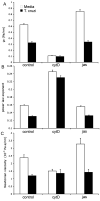Modulation of host cell mechanics by Trypanosoma cruzi
- PMID: 18853412
- PMCID: PMC2592505
- DOI: 10.1002/jcp.21606
Modulation of host cell mechanics by Trypanosoma cruzi
Abstract
To investigate the effects of Trypanosoma cruzi on the mechanical properties of infected host cells, cytoskeletal stiffness and remodeling dynamics were measured in parasite-infected fibroblasts. We find that cell stiffness decreases in a time-dependent fashion in T. cruzi-infected human foreskin fibroblasts without a significant change in the dynamics of cytoskeletal remodeling. In contrast, cells exposed to T. cruzi secreted/released components become significantly stiffer within 2 h of exposure and exhibit increased remodeling dynamics. These findings represent the first direct mechanical data to suggest a physical picture in which an intact, stiff, and rapidly remodeling cytoskeleton facilitates early stages of T. cruzi invasion and parasite retention, followed by subsequent softening and disassembly of the cytoskeleton to accommodate intracellular replication of parasites. We further suggest that these changes occur through protein kinase A and inhibition of the Rho/Rho kinase signaling pathway. In the context of tissue infection, changes in host cell mechanics could adversely affect the function of the infected organs, and may play an important role on the pathophysiology of Chagas' disease.
(c) 2008 Wiley-Liss, Inc.
Figures






Similar articles
-
Parasite-Mediated Remodeling of the Host Microfilament Cytoskeleton Enables Rapid Egress of Trypanosoma cruzi following Membrane Rupture.mBio. 2021 Jun 29;12(3):e0098821. doi: 10.1128/mBio.00988-21. Epub 2021 Jun 22. mBio. 2021. PMID: 34154418 Free PMC article.
-
A soluble factor from Trypanosoma cruzi inhibits transforming growth factor-ß-induced MAP kinase activation and gene expression in dermal fibroblasts.PLoS One. 2011;6(9):e23482. doi: 10.1371/journal.pone.0023482. Epub 2011 Sep 8. PLoS One. 2011. PMID: 21931601 Free PMC article.
-
Trypanosoma cruzi Induces the PARP1/AP-1 Pathway for Upregulation of Metalloproteinases and Transforming Growth Factor β in Macrophages: Role in Cardiac Fibroblast Differentiation and Fibrosis in Chagas Disease.mBio. 2020 Nov 10;11(6):e01853-20. doi: 10.1128/mBio.01853-20. mBio. 2020. PMID: 33172999 Free PMC article.
-
Host cell actin remodeling in response to Trypanosoma cruzi: trypomastigote versus amastigote entry.Subcell Biochem. 2008;47:101-9. doi: 10.1007/978-0-387-78267-6_8. Subcell Biochem. 2008. PMID: 18512345 Review.
-
The role of host cell lysosomes in Trypanosoma cruzi invasion.Subcell Biochem. 2008;47:165-73. doi: 10.1007/978-0-387-78267-6_13. Subcell Biochem. 2008. PMID: 18512350 Review.
Cited by
-
Role of cyclooxygenase-2 in Trypanosoma cruzi survival in the early stages of parasite host-cell interaction.Mem Inst Oswaldo Cruz. 2015 Apr;110(2):181-91. doi: 10.1590/0074-02760140311. Mem Inst Oswaldo Cruz. 2015. PMID: 25946241 Free PMC article.
-
Differential expression and characterization of a member of the mucin-associated surface protein family secreted by Trypanosoma cruzi.Infect Immun. 2011 Oct;79(10):3993-4001. doi: 10.1128/IAI.05329-11. Epub 2011 Jul 25. Infect Immun. 2011. PMID: 21788387 Free PMC article.
-
Transcriptional Studies on Trypanosoma cruzi - Host Cell Interactions: A Complex Puzzle of Variables.Front Cell Infect Microbiol. 2021 Jun 17;11:692134. doi: 10.3389/fcimb.2021.692134. eCollection 2021. Front Cell Infect Microbiol. 2021. PMID: 34222052 Free PMC article. Review.
-
Host Cell Rap1b mediates cAMP-dependent invasion by Trypanosoma cruzi.PLoS Negl Trop Dis. 2023 Mar 10;17(3):e0011191. doi: 10.1371/journal.pntd.0011191. eCollection 2023 Mar. PLoS Negl Trop Dis. 2023. PMID: 36897926 Free PMC article.
-
Mir-190b negatively contributes to the Trypanosoma cruzi-infected cell survival by repressing PTEN protein expression.Mem Inst Oswaldo Cruz. 2015 Dec;110(8):996-1002. doi: 10.1590/0074-02760150184. Mem Inst Oswaldo Cruz. 2015. PMID: 26692329 Free PMC article.
References
-
- Affranchino JL, Ibanez CF, Luquetti AO, Rassi A, Reyes MB, Macina RA, Aslund L, Pettersson U, Frasch AC. Identification of a Trypanosoma cruzi antigen that is shed during the acute phase of Chagas' disease. Mol Biochem Parasitol. 1989;34(3):221–228. - PubMed
-
- An SS, Fabry B, Mellema M, Bursac P, Gerthoffer WT, Kayyali US, Gaestel M, Shore SA, Fredberg JJ. Role of heat shock protein 27 in cytoskeletal remodeling of the airway smooth muscle cell. J Appl Physiol. 2004;96(5):1701–1713. - PubMed
-
- Andrade LO, Andrews NW. The Trypanosoma cruzi-host-cell interplay: location, invasion, retention. Nat Rev Microbiol. 2005;3(10):819–823. - PubMed
-
- Atance J, Yost MJ, Carver W. Influence of the extracellular matrix on the regulation of cardiac fibroblast behavior by mechanical stretch. J Cell Physiol. 2004;200(3):377–386. - PubMed
Publication types
MeSH terms
Substances
Grants and funding
LinkOut - more resources
Full Text Sources

